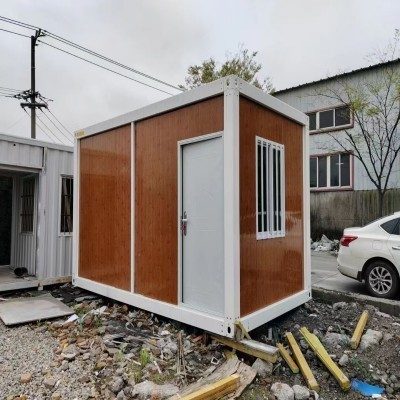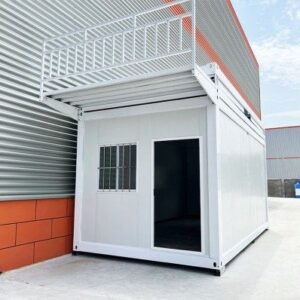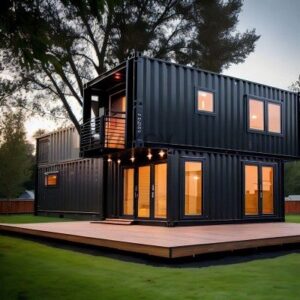What Are Shipping Container Houses
Shipping container houses are homes built using steel freight containers originally designed for transporting goods. These containers come in various sizes, with 20-foot and 40-foot units being the most common. There are several types of container homes:
- Single container units created as compact living spaces
- Stacked or combined containers for larger, multi-room layouts
- Custom modified containers tailored with cutouts for windows, doors, and insulation
These homes are increasingly popular in modern construction due to their cost-effectiveness, eco-friendliness, and quick build times. Using repurposed containers reduces waste, and their modular nature offers flexible design options.
Shipping container homes have a wide range of common uses, including:
- Residential living offering affordable, durable housing solutions
- Commercial applications like pop-up shops, offices, or studios
- Emergency and temporary housing because they’re quick to transport and set up, ideal for disaster relief or remote locations
In short, shipping container houses combine strength, sustainability, and flexibility—making them an appealing choice for many today’s housing and commercial needs.
Average Lifespan of Shipping Container Houses and Factors That Affect Longevity
Shipping container houses generally have an average lifespan between 20 and 50 years, and with proper care, they can last even longer. This range depends largely on several critical factors that influence durability and long-term performance.
What Influences Shipping Container Home Lifespan
- Material QualityMost shipping containers are built from high-grade steel, designed to withstand harsh ocean conditions. However, the steel grade and protective coatings used in your container home’s build significantly affect how well it resists rust and corrosion over time.
- Build Quality and ConstructionProper modifications, like cutting for windows and doors, must be done carefully to avoid compromising structural integrity. Reinforcements and quality welding extend the container’s life.
- Environmental FactorsExposure to moisture, humidity, and salty air (in coastal areas) accelerates rusting and wear. Containers in dry inland climates typically last longer than those near the ocean.
Lifespan Comparison with Traditional Homes
| Home Type | Typical Lifespan | Longevity Challenges |
|---|---|---|
| Shipping Container | 20-50+ years | Rust, corrosion, structural weakening |
| Wood Frame Homes | 30-80 years | Rot, termites, moisture damage |
| Concrete Homes | 50-100+ years | Cracking, moisture penetration |
Compared to traditional wooden homes, container houses avoid common issues like termites and rot but face unique risks like rust and steel fatigue. Against concrete homes, containers generally have a shorter lifespan but can be more cost-effective and faster to build.
For a deeper dive into lifespan and maintenance tips, check How Long Shipping Container Houses Last.
Key Factors Affecting the Durability of Shipping Container Homes
The durability of shipping container homes largely depends on several critical factors. Understanding these can help you make better choices and extend the lifespan of your container house.
Material Quality and Protective Coatings
The steel used in shipping container homes can vary in quality. The steel grade and its resistance to rust play a huge role in longevity. High-quality steel, especially Corten steel (also called weathering steel), is designed to withstand corrosion better than standard steel.
Protective treatments are essential:
- Anti-rust coatings and specialized paints prevent moisture from eating away at the metal.
- Regular repainting with rust-resistant paint keeps the steel protected against weather wear.
Environmental Exposure
Where your container home sits affects how long it lasts. Coastal areas have salty air that speeds up corrosion and rust, while inland climates with less humidity are kinder to steel structures.
Key environmental considerations:
- Moisture and humidity levels directly impact rust formation.
- Exposure to extreme weather like heavy rain, snow, or intense sun can break down protective layers faster.
Maintenance and Upkeep
Routine care is non-negotiable if you want a long-lasting container home. That means:
- Frequent inspections to spot rust or damage early.
- Timely repainting and rust treatments to maintain the protective barrier.
- Keeping gutters, seals, and drainage systems clean to avoid water buildup.
Construction and Modification Quality
How your container home is modified matters as much as the base materials. Poor workmanship when cutting windows, doors, or adding reinforcements can weaken the structure and let moisture in.
Focus on:
- Structural reinforcements around cuts to maintain integrity.
- Proper sealing of openings to prevent leaks and rust spots.
Foundation and Installation Practices
A solid foundation is key to the longevity of any home, especially shipping container houses. If the container isn’t properly leveled or supported, it can sag or twist over time, causing structural problems.
Important foundation factors:
- Using strong, durable supports that hold the weight evenly.
- Preventing ground moisture from reaching the container’s base through good drainage.
By paying close attention to these key areas—material quality, environmental exposure, maintenance, construction, and foundation—you can greatly improve the durability and lifespan of your shipping container home.

Signs Your Shipping Container Home Needs Repairs or Replacement
Knowing when your shipping container home needs repairs or a full replacement is crucial for keeping it safe and durable. Here are the key signs to watch out for that indicate your container house might be struggling:
Corrosion Spots and Rust Patterns
- Rust is the biggest enemy of shipping container homes. Small spots of rust or surface corrosion can be treated, but widespread rust or deep pitting weakens the steel structure.
- Look for flaking paint, bubbling metal, or rough surfaces—these are early signs of corrosion spreading.
- Rust that forms near seams and welds is particularly concerning because it can impact the overall structural integrity.
Structural Deformities or Sagging
- Warping, bulging, or sagging walls and roofs are serious indicators of structural issues.
- These deformities might happen due to improper installation, heavy modifications like cutting large windows or doors, or damage from extreme weather.
- If you notice uneven floors or doors and windows that don’t align or open properly, the frame may be compromised.
Insulation Failure or Leaks
- A key sign your container home needs attention is water leaks or moisture stains inside.
- Insulation breaks down over time, especially if exposed to constant moisture. This can cause condensation issues, mold growth, and higher energy bills.
- Cracks or gaps where panels join or around windows and doors can let water in, leading to further damage.
Door and Window Integrity Problems
- Doors and windows on container homes are often custom modifications. Over time, the frames can warp or rust, causing problems with opening and closing.
- If you notice drafts, difficulty locking, or moisture buildup around these areas, it’s time for an inspection.
- Damaged seals or broken hardware can reduce security and energy efficiency.
Paying close attention to these signs can help you keep your shipping container home in top shape and extend its lifespan significantly. Regular inspections and timely repairs are key to preventing costly damage down the road.
Maintenance Tips to Extend the Lifespan of Your Shipping Container Home
Keeping your shipping container home in good shape requires regular care focused on preventing rust, water damage, and structural issues. Here are some practical tips to help you maximize your container home’s durability and overall lifespan.
Routine Exterior Inspections and Rust Prevention
- Inspect your container home regularly, especially in areas where rust tends to develop, like corners and weld points.
- Look for rust spots early and treat them quickly with rust converters or sand them down before repainting.
- Use high-quality, rust-resistant paints and coatings designed for steel to protect the exterior metal from corrosion.
- Keep metal surfaces clean and free from dirt buildup, which can trap moisture and speed up rusting.
Waterproofing and Sealing Techniques
- Apply waterproof sealants around windows, doors, and any roof joints to prevent leaks and water infiltration.
- Use flexible sealants that can handle temperature changes without cracking.
- Check the roof’s condition seasonally, especially after storms, and repair any cracks or gaps immediately.
- Proper sealing keeps moisture out, which is essential to avoid insulation damage and interior mold issues.
HVAC and Insulation Maintenance
- Inspect and maintain your home’s insulation regularly to ensure it’s dry and intact. Wet or damaged insulation loses effectiveness and invites mold.
- Service your heating and cooling systems to prevent excess humidity inside, which can cause condensation on the steel walls.
- Consider upgrading to energy-efficient HVAC units that better manage indoor climate and reduce moisture buildup.
- Proper ventilation combined with insulation maintenance helps protect the container’s internal structure long-term.
Landscaping and Drainage Management
- Maintain good drainage around your home’s foundation to avoid standing water that accelerates rust and foundation issues.
- Grade the land so water flows away from the container rather than pooling near the base.
- Keep plants and trees trimmed back to prevent branches from scratching or denting the exterior steel.
- Consider installing gutters or drainage channels to efficiently divert rainwater away from the structure.
By following these maintenance steps consistently, you can significantly extend the lifespan of your shipping container home and maintain its structural integrity for decades.
Innovations and Upgrades Improving Shipping Container Longevity
Shipping container homes are getting smarter and tougher with new innovations designed to boost their lifespan and durability. Here are some of the key upgrades that help extend how long shipping container houses last:
Use of Corten Steel and Weathering Steel Variants
Corten steel is a game-changer for container homes because it naturally forms a protective rust layer that shields the steel underneath from further corrosion. Compared to standard steel, containers made from or clad with weathering steel like Corten resist rust much better, especially in harsher climates. This means less maintenance and a longer-lasting structure.
Modern Anti-Corrosion Coatings and Paints
Advancements in anti-corrosion coatings have also improved container home durability. These modern paints and treatments create strong barriers against moisture and salt, which are the biggest culprits in container rust. Regular application of high-quality protective paint significantly slows down corrosion, keeping your home structurally sound for decades.
Smart Monitoring Systems for Structural Health
Technology is stepping up with smart monitoring systems that track the integrity of shipping container homes in real-time. These systems can detect early signs of structural stress, corrosion, or leaks before they become serious problems. Early detection allows for timely repairs, which boosts the overall lifespan of your container house.
Energy-Efficient Retrofit Options for Climate Control
Adding energy-efficient retrofits not only improves comfort but also protects the container’s materials. Upgrades like better insulation, vapor barriers, and efficient HVAC systems reduce moisture buildup and temperature swings inside the container. Controlling these factors helps prevent rust and material fatigue, contributing to longer durability.
By combining these innovations, container homes are not just lasting 20 to 50 years or more, but also offering improved comfort and lower maintenance costs—making them a more reliable investment for U.S. homeowners looking for sustainable, durable housing options.
Environmental and Economic Benefits of Long Lasting Shipping Container Houses
Shipping container houses offer clear environmental and economic benefits, especially when built and maintained for the long haul. These advantages make them a smart investment for those looking beyond just upfront costs.
Sustainability Through Reuse and Recyclability
One of the biggest green wins with shipping container homes is their reuse of existing materials. Instead of cutting down new resources like wood or mining for concrete, these homes repurpose steel containers that might otherwise sit unused or be scrapped.
- Steel containers are 100% recyclable, reducing waste significantly.
- Using containers lowers the demand for traditional building materials, which often have bigger carbon footprints.
- Repurposing reduces construction waste compared to conventional home builds.
This sustainability angle is increasingly important for homeowners who want eco-friendly living without sacrificing durability.
Cost Effectiveness of Maintenance vs Rebuilding Traditional Homes
Maintaining a shipping container home is generally more cost-effective over time compared to rebuilding traditional wooden or concrete houses. Steel’s durability means you spend less on major repairs, but only if you stay on top of proper upkeep.
| Cost Aspect | Shipping Container Home | Traditional Home |
|---|---|---|
| Initial Build Cost | Competitive with modest-sized homes | Often higher due to materials & labor |
| Routine Maintenance | Focus on rust prevention and sealing | Frequent painting, patching, repairs |
| Major Repairs/Rebuilding | Less frequent with good maintenance | More common due to rot, pests, weather damage |
| Lifespan Potential | 20-50 years or more | 30-80+ years depending on materials |
Because steel containers resist pests, rot, and fire better than wood, container homes can save money that would otherwise go toward costly repairs in traditional houses.
Impact on Resale Value and Insurance Considerations
Long lasting container homes can positively affect resale value and insurance:
- Resale Value: Well-maintained container homes retain value thanks to their durability and unique appeal. Buyers looking for sustainable, low-maintenance housing often view these homes as a strong investment.
- Insurance: Insurance providers may offer better rates for container homes in some areas due to their resistance to fire, wind, and pests, but coverage depends on build quality and local codes.
It’s important to keep records of regular maintenance and inspections to demonstrate your container home’s structural integrity and longevity to potential buyers or insurers.
For those interested in learning more about building costs and investment value, check out our detailed guide on How Much Does a Shipping Container House Cost.
Frequently Asked Questions About Shipping Container House Lifespan
How often should I repaint my shipping container home
To prevent rust and corrosion, it’s best to repaint your shipping container home every 5 to 7 years, depending on your local climate conditions. Homes in humid or coastal areas may need more frequent attention, whereas those in dry, inland regions might go longer. Regular repainting keeps the protective coatings intact and extends the home’s durability.
Can container homes last longer than 50 years
Yes, with proper maintenance and quality materials, shipping container homes can easily last beyond 50 years, sometimes even a lifetime. Factors like using Corten steel, keeping up with rust treatments, and ensuring solid construction play a big role in pushing that lifespan well past the typical 20 to 50-year range.
Are container homes safe in extreme weather
Shipping container homes are inherently strong due to their steel frame, making them resilient against extreme weather like high winds, heavy snow, and seismic activity. However, safety also depends on proper foundation work, structural reinforcements, and insulation. With these in place, container homes compare favorably to traditional homes in storm resistance and durability.
What warranties are typical for container home materials
Warranties vary, but most steel shipping containers and container home materials come with corrosion and structural warranties ranging from 10 to 25 years. These often cover defects in the steel and protective coatings but not damage from poor maintenance or environmental wear. Always check with builders and suppliers to understand what’s covered before investing



